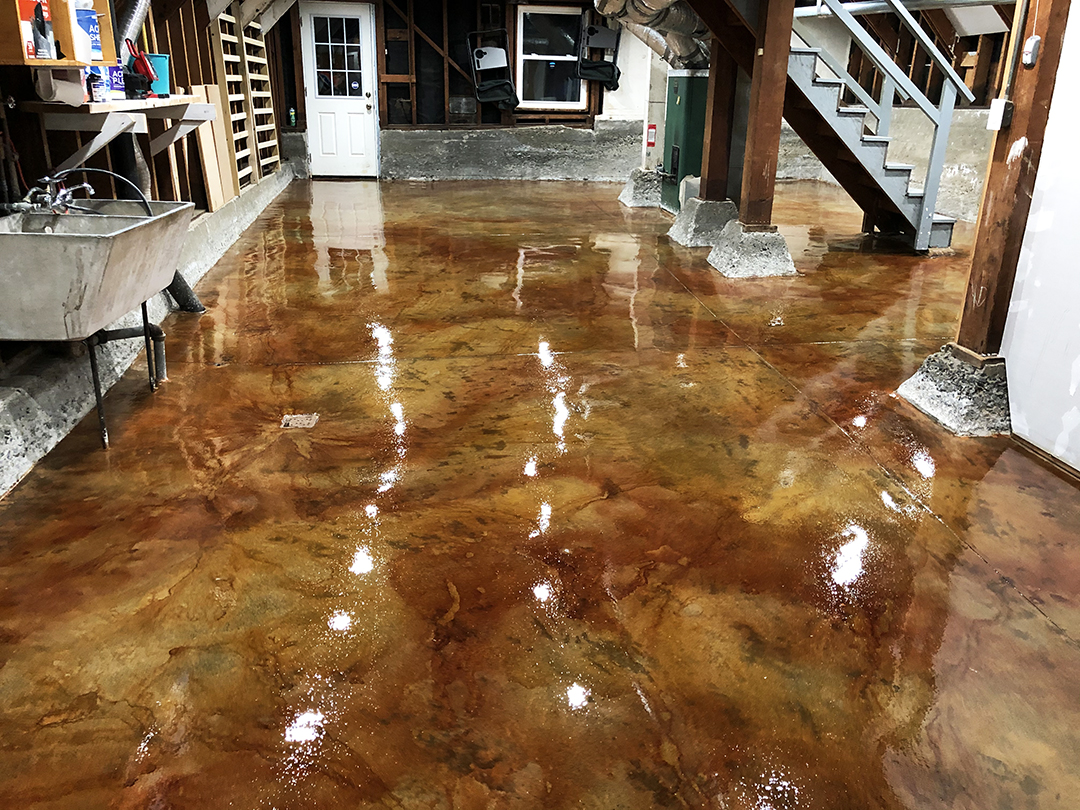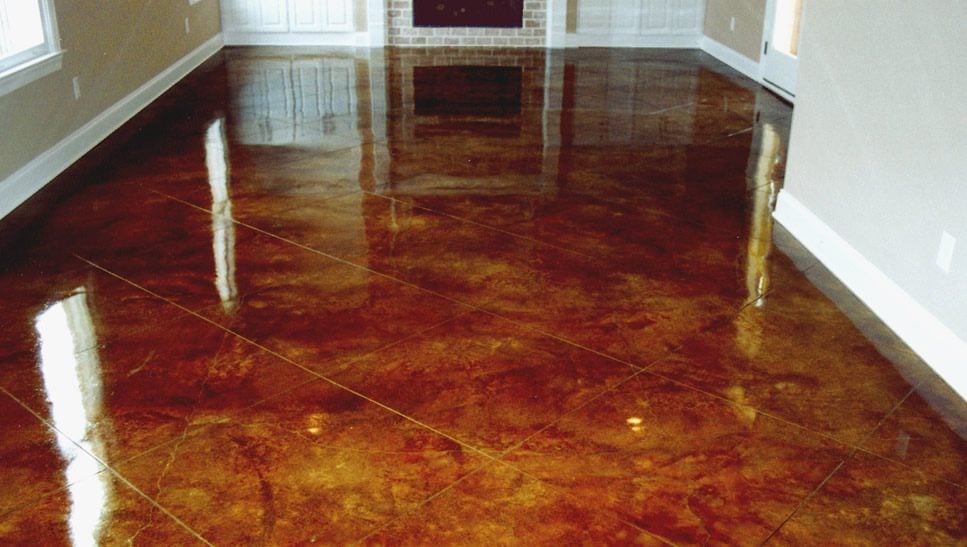Things you didn’t know about stained concrete floors austin texas
Wiki Article
Understanding the Various Kinds of Stained Concrete for Your Following Project
Stained concrete offers different options that satisfy various visual and useful requirements. Each kind presents distinct qualities that affect the final appearance and resilience of the surface. Understanding these differences is key for anyone preparing a task. From rich, chain reactions of acid-based stains to the lively uniformity of strong shade stains, the choices can substantially impact the end result. What elements should one think about when picking the ideal tarnish for their certain needs?Overview of Stained Concrete
Stained concrete functions as a functional flooring option that can enhance the aesthetic appeal of numerous spaces. This method includes applying a coloring representative to the surface area of existing concrete, enabling a wide spectrum of design opportunities. Stained concrete is preferred in both residential and commercial settings, supplying a long lasting and low-maintenance service that can simulate the appearance of all-natural products like stone or ceramic tile.The staining procedure can be implemented utilizing water-based or solvent-based products, each offering distinct visual impacts. The final appearance is affected by variables such as the original concrete surface, the sort of discolor utilized, and the application approach. Stained concrete not just improves exterior and interiors but likewise advertises sustainability by renewing existing concrete frameworks. Therefore, it has actually gained grip among property owners and designers looking for both performance and style in their floor covering choices.
Acid-Based Stains: Features and Benefits

One-of-a-kind Color Variations
Concrete surfaces can change dramatically with the application of acid-based stains, which use an abundant palette of distinct color variations. These stains pass through the concrete, reacting chemically to generate lively planet tones that range from deep browns and reds to soft eco-friendlies and blues. The resulting shades are often variegated, developing a natural, marble-like look that improves the concrete's personality. Each application yields unique outcomes as a result of variants in the concrete's structure and the staining method made use of, making every job unique. Furthermore, acid-based stains can be layered or integrated with other techniques to create customized designs, permitting personal expression. This flexibility makes acid-based stains a prominent option for both household and business applications.Chain Reaction Explained
While numerous factors add to the performance of acid-based stains, the underlying chemical reactions play an important function in their one-of-a-kind qualities and advantages. These stains mostly are composed of water, acid, and metallic salts. When related to concrete, the acid reacts with the calcium hydroxide in the concrete, producing a chemical transformation that causes irreversible shade modifications. The metal salts permeate the surface and bond with the concrete, permitting a vast variety of colors and tones. This reaction not just improves visual charm but likewise provides durability, making the shade immune to fading and wear. Furthermore, acid-based stains can develop a variegated finish that imitates natural stone, further enhancing their popularity for ornamental concrete applications.Surface Preparation Value
Attaining ideal outcomes with acid-based stains pivots on extensive surface preparation. This essential action assurances that the concrete surface area is clean, without pollutants, and correctly profiled for excellent discolor absorption. Any kind of existing sealants, dust, or oils can prevent the chain reaction that generates the wanted shade and finish, leading to irregular or patchy results.Prior to applying the tarnish, the concrete ought to be mechanically cleaned or stress washed, adhered to by a detailed examination for splits or blemishes that may need fixing. In addition, verifying the surface is properly dried out will certainly boost tarnish adherence. By focusing on these preparatory actions, the longevity and vibrancy of acid-based stains can be greatly improved, causing an extra cosmetically pleasing and sturdy surface.
Water-Based Stains: Attributes and Advantages

Water-based stains permeate the concrete, providing a much more transparent coating that highlights the all-natural appearance and variants of the surface underneath. They are readily available in a vast variety of shades, allowing for innovative versatility in layout. In addition, water-based stains are less complicated to clean up, needing only water and soap, which streamlines the application process.
Their fast drying time boosts performance, making them a useful choice for both do it yourself fanatics and professionals. Generally, water-based stains provide an attractive mix of aesthetic convenience and easy to use buildings, making them a popular alternative for concrete enhancement tasks.
Solid Color Stains: Vivid Alternatives for a Strong Look
Solid shade stains use an effective solution for those looking for to develop a bold and vibrant aesthetic on concrete surfaces. These stains offer a consistent coloration that can dramatically boost the aesthetic allure of floors, patio areas, and read more driveways. Offered in a wide spectrum of shades, strong shade stains allow for imaginative expression, accommodating numerous style choices.Among the crucial benefits of solid color stains is their capacity to conceal blemishes, supplying a fresh and refined seek to maturing concrete - Stained Concrete Floors Austin Tx. In addition, their solution generally includes UV-resistant residential or commercial properties, ensuring long life and color retention even in severe climate condition
Application is uncomplicated, calling for very little prep work of the concrete surface area. As soon as used, solid color stains can be secured for added defense and luster, further raising their aesthetic high quality. With their lively options, strong shade stains are an exceptional choice for those intending for an impactful and natural style.
Semi-Transparent Stains: Accomplishing Depth and Dimension
Semi-transparent stains use a special method to boosting concrete surfaces by supplying depth and measurement through different color choices. Understanding the application techniques is essential for attaining the preferred result, while proper upkeep techniques ensure long life. This section will discover these crucial aspects to take full advantage of the advantages of semi-transparent staining.Shade Options Available
A vast variety of shade alternatives exists for semi-transparent stains, allowing house owners and developers to enhance the natural appeal of concrete surface areas. These stains come in a variety of tones, from earthy tones like browns and terracottas to vibrant colors such as blues and eco-friendlies. The semi-transparent nature of these stains permits the underlying concrete to reveal through, creating a special depth and measurement that can enhance numerous design visual appeals. In addition, incorporating different colors can generate personalized tones, allowing a tailored search for each task. This flexibility makes semi-transparent stains a prominent choice for both interior and exterior applications, as they can balance with surrounding components while adding visual rate of interest to simple concrete.Application Strategies Clarified
To attain the desired depth and measurement with semi-transparent stains, correct application techniques are vital. First, surface prep work is critical; the concrete must be clean and without any contaminants. This frequently involves power cleaning and fixing any type of fractures. Next, picking the appropriate applicator, such as a sprayer, roller, or brush, can affect the final appearance. Sprayers enable a much more even application, while rollers can aid attain texture. It is very important to use the stain in slim, also coats, permitting each layer to completely dry before adding an additional. Manipulating the application technique, such as differing pressure or using various devices, can produce unique impacts. Finally, securing the stained surface boosts the vibrancy of the colors while giving defense.Upkeep Best Practices
Routine upkeep is crucial for protecting the elegance and honesty of surfaces treated with semi-transparent stains. To keep these surfaces, routine cleansing is vital. Utilizing a pH-neutral cleaner and a soft-bristle mop will assist get rid of dirt and particles without harming the stain. It is suggested to avoid extreme chemicals, as they can degrade the discolor's look. Furthermore, regular resealing every one to three years can secure versus wear and fading. This process includes cleaning up the surface area thoroughly and applying a compatible sealant made for stained concrete. House owners must additionally check for any kind of signs of discoloration or damages and address these problems promptly to guarantee long-lasting vibrancy and toughness. Following these finest methods will enhance the overall lifespan of semi-transparent stained surface areas.Effects and Methods: Tailoring Your Stained Concrete
Tailoring stained concrete entails an array of methods that boost both aesthetic appeals and performance. Among these techniques, layering different stain colors can develop deepness and intricacy, permitting for special aesthetic impacts. Techniques such as acid staining provide a variegated appearance, while water-based stains supply an extra consistent appearance.In addition, incorporating decorative patterns, such as stenciling or inscription, can additionally individualize the surface area, including complex designs that cater to specific preferences. Texturing the concrete, whether through stamping or mop surfaces, introduces responsive components that not only improve grasp however likewise enhance aesthetic passion.
Using sealers can enhance the color vibrancy and give security against wear. Customization strategies prolong past simple shade; they can change a basic concrete slab right into a spectacular focal point, making it ideal for both domestic and business areas. Via cautious choice of results and methods, stained concrete can attain a really customized appearance.
Upkeep and Longevity of Stained Surfaces
Although stained concrete surface areas are known for their durability and visual charm, maintaining their integrity is necessary for making certain longevity. Regular cleaning is crucial; sweeping and wiping with a pH-neutral cleaner helps avoid dirt buildup and discoloration. In addition, applying a sealant every few years can safeguard the surface area from moisture, chemicals, and UV damages, thereby enhancing its life expectancy.It is likewise important to deal with any fractures or chips immediately. Small repairs can reduce additional damage, protecting the visual and architectural quality of the surface. For outside stained concrete, seasonal upkeep, such as removing snow and ice, is necessary to stop surface damage from freeze-thaw cycles.
Often Asked Concerns
Can I Stain Existing Concrete Surfaces or New Ones?
The question of whether existing concrete surface areas can be stained develops often. It is certainly possible to discolor both new and old concrete, gave the surface area is appropriately ready and without contaminants for optimal bond.Just how Lengthy Does the Discoloration Refine Generally Take?
The staining procedure commonly takes one to 3 days, depending on variables such as surface prep work, sort of tarnish, and weather condition conditions. Austin Stained Concrete Floors. Treating time might extend beyond initial application, affecting the overall period considerablyIs Stained Concrete Safe for Outdoor Usage?
Stained concrete is typically secure for outdoor usage, provided it is properly sealed. This sealing shields against wetness and UV damages, guaranteeing resilience and safety and security, while also improving the visual appeal of outside areas.Can I Use Several Discoloration Layers for Different Impacts?
Using multiple tarnish layers can achieve different impacts on stained concrete. It is crucial to assure compatibility between stains and allow appropriate drying out time between applications to avoid unexpected responses or discoloration.Are There Any Type Of Shade Limitations for Stained Concrete?
Color limitations for stained concrete mostly rely on the sort of tarnish used, with water-based stains providing a more comprehensive scheme contrasted to acid-based stains. Stained Concrete Austin. Nevertheless, accomplishing lively colors may require careful selection and application techniquesReport this wiki page